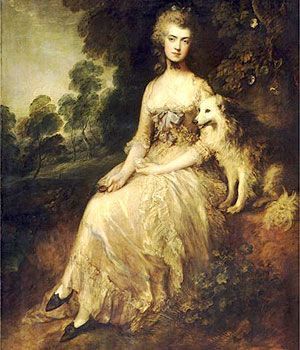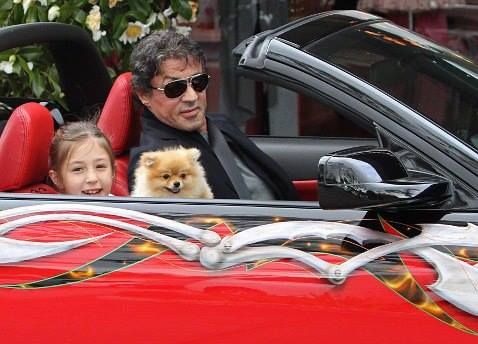Pom History
Sub-links for this page
An interesting fact of this breed, is that the female should weigh more (be larger) than the male. The Australian National Kennel Club Breed Standard states - while there is NO HEIGHT STIPULATION this breed standard it does state "the perfect weight range of the male Pomeranian is between 1.8 to 2.0 kilograms" (4.0 to 4.5 pounds) with the female's perfect weight range, being 2.0 to 2.5 kilograms (4.5 to 5.5 pounds).
Marie Antoinette, Emile Zola and Mozart all owned Pomeranians.
 In the late 1800's Queen Victoria became a Pomeranian fancier, and established her own kennel for their breeding. She showed her dogs, with some success, making the breed very popular in England.
In the late 1800's Queen Victoria became a Pomeranian fancier, and established her own kennel for their breeding. She showed her dogs, with some success, making the breed very popular in England.
Because Queen Victoria preferred smaller dogs, many breeders began selecting for smaller size.

CRUFTS, A POMERANIAN HISTORY..click picture left to view this informative documentary.
The tiny Pomeranian is a member of one of the oldest groups of dogs known - the Neolithic times are very similar to the present day spitz breeds and remains of spitz-type dogs have been found throughout Asia, in the Pacific Islands and the African interior. The spitz type has been identified in Egyptian drawings from the time of the pharaohs and representations have been found in ancient Mycenae and Italy. Remains have also been discovered in the Celtic settlement of Siggenthal and the Roman colony of Vindonissa.
The Pomeranian was probably the first spitz breed to arrive in England, and was definitely known by the late 18th century. Around the 1770s Thomas Gainsborough pained three pictures featuring the breed - Pomeranian Bitch and Puppy, The Morning Walk and Mrs Perdita Robinson - and all three paintings show large, while, spitz-type dogs.
Royal Doulton issued a figurine around this time called "Welcome Home" showing a small girl being welcomed by her Pomeranian; this figurine has been re-issued.
The Pomeranian certainly seems to have a very early traceable history which can be divided into three periods -
1. Prehistoric
2. European; and
3. Modern, dating from the 18th century onwards.
There is no doubt that the Pomeranian is descended from the Wolf Spitz of the northern climes. These include a variety of dogs like the Eskimo and Kamtchadales, the Laika family found in Russia, and the white Samoyed dogs, which belonged to a tribe living in the northwest regions of Siberia. All these Wolf Spitz dogs were used for drawing sledges and for guarding and rounding up herds of reindeer. The Samoyeds were of all colours and the white variety came from early crosses with the White Artic Wolf.
It's interesting just how the Pomeranians got their name, which was only given them in the last century. There is a state called Pomerania, which is situated on the eastern side of Germany near Poland. In this state there is a province called Samogitia. The inhabitants of Samogitia arrived from Finland centuries ago and settled in the area, no doubt bringing their Spitz dogs with them. A number of these were known as Pommer. It's interesting that in Sweden they were known as Pommerska Spetsen, and in England in 1803 as 'Fox Dogs'.
In appearance, all the Wolf Spitz breeds of dog have kept their original wolf-like characteristics. These include the prick ears, the abundant thick coats with the harsh guard hairs and the typical wedge-shaped head and the tail lying over the back.
It's astonishing how much the breed has changed in size in two hundred years, as is seen in George IV's Pomeranian by Stubbs painting. The Pomeranian was bred smaller and smaller, so that by 1915 the large Pomeranian was no longer exhibited in England.
Please use the attached links to view the full history of this breed: https://janedogs.com/pomeranian/ and www.pomeranianproject.com/
Other Miscellaneous info:
Sylvester Stallone has a pomeranian called "Woody" bred by Jan Shars kennel.

Mozart had a Pomeranian called ‘Pimperl’ he wrote an aria to express his true love for his beloved Pom.
The great Genius, Sir Isaac Newton, owned a Pomeranian called ‘Diamond’.
Michelangelo also owned a Pomeranian and often had him with him while painting the ceiling of the Sistine Chapel.
Many famous paintings have included the Pomeranian, for instance - Pomeranian and Puppy and Mrs Robinson & Pomeranian by Gainsborough. Gainsborough added the same dog to many of his pictures, the dog is white and of the size they used to be.
Only two dogs survived the sinking of the Titanic and one was a Pomeranian owned by Miss Margaret Hayes of New York who boarded lifeboat no 7 with her Pom
On May 1st 1907, The British Pomeranian Club held its first show; it was held in England, Belle Vue Manchester
Have you heard the Pomeranian song by Nancy Simmons? It's all about her Pomeranian and why everyone should get a Pom. You can purchase it on the Internet...http://www.lyrics.com/nancysimmonds
We here in Australia exhibit our Pomeranian Dogs under the British Pomeranian Standard,..https://www.thekennelclub.org.uk/breed-standards/toy/pomeranian/
Also, we occasionally have FCI shows which are judged under the FCI Pomeranian Standard (as below).

FCI POMERANIAN STANDARD The Fédération cynologique internationale (FCI) (English: International Canine Federation) is the largest international federation of national
DATE OF PUBLICATION OF THE ORIGINAL VALID STANDARD : 05.03.1998.
UTILIZATION : Watch and Companion Dog.
CLASSIFICATION F.CJ. : Group 5 Spitz and primitive types. Section 4 European Spitz. Without working trial.
BRIEF HISTORICAL SUMMARY : German Spitz are descendants of the stone age «Peat Dogs» (Torfhund) «Canis familiaris palustris Riithimeyer» and the later Lake Dweller's (Pfahlbau) Spitz; they are the oldest breed of dog in Central Europe. Numerous other breeds have been produced from them. In non-German speaking countries Wolfsspitz are known as Keeshonds and Toy Spitz as Pomeranians.
GENERAL APPEARANCE : Spitz breeds are captivating on account of their beautiful coats, made to stand off by plentiful undercoat. Particularly impressive is the strong, mane-like collar round the neck (ruff) and the bushy tail carried boldly over the back. The foxy head with alert eyes and the small pointed, closely set ears give the Spitz his unique characteristic, cheeky appearance.
IMPORTANT PROPORTIONS : The ratio of height at withers to body length is 1 : 1.
BEHAVIOUR AND CHARACTER : The German Spitz is always attentive, lively and exceptionally devoted to his owner. He is very teachable and easy to train. His distrust to strangers and lack of hunting instinct make him the ideal watchdog for home and farm. He is neither timid nor aggressive. Indifference to weather, robustness and longevity are his most outstanding attributes.
HEAD
CRANIAL REGION : The Spitz's medium size head, seen from above, appears broadest at the back and tapers in wedgeshape to thi tip of the nose. Stop : Moderate to marked, never abrupt.
FACIAL REGION :
Nose : The nose is round, small and pure black, dark brown in brown Spitz.
Muzzle : The muzzle is not overlong and stands in pleasing
proportion to the skull. (In Wolfspitz/Keeshond, Giant Spitz and
Medium-size Spitz the ratio length of the muzzle to length of the skull is approximately 2:3, in Miniature Spitz and Toy Spitz approximately 2:4..
Lips : The lips are not exaggerated, close fitting to the jaws and do not form any folds to the corner of the mouth. They are completely black in all colours, brown in brown Spitz.
Jaws/Teeth : The jaws are normally developed and show a complete scissor bite with 42 teeth, corresponding to the teeth formula of the dog, i.e. the upper teeth closely overlapping the lower teeth and set square to the jaws. Pincer-bite is permissible in all varieties of Spitz.
Cheeks : The cheeks are gently rounded, not protruding.
Eyes : The eyes are of medium size, longish shape, slightly slanting and dark. The eyelids are black in all shades of colour, dark brown in brown Spitz.
Ears : The small ears are set high and relatively close to each other, triangular and pointed; they are always carried upright, stiff at the tips.
NECK : The medium length neck is set broadly into the shoulders, slightly arched without throatiness and covered by a thick, profuse coat forming a large ruff.
BODY:
Topline : The topline starts at the tips of the erectly carried prick-ears and merges in a gentle curve with the short, straight back. The bushy, sweeping tail, which partially covers the back, rounds off the silhouette.
Withers/Back: : The high withers drop imperceptibly into the shortest possible, straight, firm back.
Loin : Short-coupled, broad and strong.
Croup : The croup is broad and short, not falling away.
Chest: The deep chest is well sprung, the forechest well developed.
Lower line : The brisket reaches as far back as possible; the belly has only a slight tuck up.
TAIL : The tail is set on high and of medium length. It reaches upwards and rolls forward over the back, straight from the root. It lies firmly over the back and is covered with very bushy hair. A double curl at tip of tail is tolerated.
LIMBS
FOREOUARTERS :
General : Straight, rather broad front.
Shoulders : The shoulder-blade is long and well laid back. The upper arm, which is approximately the same length, forms an angle of 90 degrees to the shoulder-blade. The shoulder is well muscled and firmly connected to the brisket.
Elbow : The elbow joint is strong, close fitting to the brisket and turns neither in nor out.
Forearm : The forearm is of medium length in relation to the body, sturdy and completely straight. The back of the forearm is well feathered.
Metacarpus (Pastern): The strong, medium length front pastern stands at an angle of 20 degrees from the vertical.
Front feet : The front feet are as small as possible, round and closed, so called cat feet, with well arched toes. Toe-nails and pads are black in all shades of colour, but dark brown in brown dogs.
HINDQUARTERS :
General : The hindquarters are very muscular and abundantly feathered to the hocks. The hind legs stand straight and parallel.
Upper and lower thigh : Upper and lower thigh are of about equal length.
Stifle : The stifle joint is strong with only moderate angulation and is turned neither in nor out in movement.
Metatarsal (Hock) : The hock is of medium length, very strong and vertical to the ground.
Hind feet: The hind feet are as small as possible, tightly closed with well arched toes, so called "cat feet". The pads are coarse. The colour of nails and pads is as dark as possible.
GAIT/MOVEMENT : The German Spitz moves straight ahead with good drive, fluid and springy.
SKIN : The skin covers the body tightly without any wrinkles.
COAT
HAIR : The German Spitz has a double coat: Long, straight, stand off top coat and short, thick, cotton-wool-like undercoat. Head, ears, front side of front and hind legs and the feet are covered by short, thick (velvety) hair. The rest of the body has a long rich coat. Not wavy, curly or corded, not parted on the back. Neck and shoulders are covered by a thick mane. The backside of the front legs is well feathered, the hind legs have ample feathering from croup to hocks. The tail is bushy.
COLOUR:
a) Wolfspitz/Keeshound : Grey shaded.

b) Giant-Spitz : Black, brown, white.

c) Medium size Spitz : Black, brown, white, orange, grey-shaded, other colours.

d) Miniature Spitz : Black, brown, white, orange, grey-shaded, other colours.

e) Toy Spitz/Pomeranian : Black, brown, white, orange, grey-shaded, other colours.
Black Spitz : In the black Spitz, the undercoat and skin must also be black and the colour on top must be a shining black without any white or other markings.
Brown Spitz : The brown Spitz should be uniformly dark brown.
White Spitz : The coat should be pure white without any trace of yellow in particular, which often occurs, specially on the ears.
Orange Spitz : The orange Spitz should be evenly coloured in the medium colour range.
Grey-shaded Spitz Keeshond / Keeshond : Grey-shaded is a silver grey with black hair-tips. Muzzle and ears dark in colour; round the eyes well defined « spectacles » shown as a delicately pencilled black line slanting from outer corner of eye to lower corner of ear, coupled with distinct markings and shading forming expressive short eyebrow; mane and ring on shoulder lighter; fore- and hindlegs without any black marking under the elbows or stifles, except slight pencilling on the toes; black tip of tail; underside of tail and trousers pale silver grey.
Other coloured Spitz : The term « other colours » covers all shades of colour, such as : cream, cream-sable, orange-sable, black and tan and particolour (with white always as main colour). The black, brown, grey or orange patches must be distributed over the whole body.
SIZE AND WEIGHT :
Height at the withers : a) Wolfspitz/Keeshond 49 cm +/- 6 cm
b) Giant Spitz 46 cm +/- 4 cm
c) Medium size Spitz 34 cm +/- 4 cm
d) Miniature Spitz 26 cm +/- 3 cm
e) Toy Spitz/Pomeranian 20 cm +/- 2 cm Dogs under 18 cm undesirable.
Weight : Each variety of German Spitz should have a weight corresponding to its size.
FAULTS : Any departure from the foregoing points should be considered a fault and the seriousness with which the fault should be regarded should be in exact proportion to its degree.
SERIOUS FAULTS :
• Faults in construction.
• Head too flat; distinct apple head.
• Flesh-coloured nose, eyelids and lips.
• In Wolfspitz/Keeshond, Giant Spitz and Medium size Spitz missing teeth.
• Faults in movement.
• In grey-shaded Spitz missing of distinct markings of the face.
ELIMINATING FAULTS :
• Gap in fontanel.
• Over-or undershot bite.
• Ectropion or entropion.
• Semi-pricked ears.
• Definite white patches in all not white Spitz.
N.B. : Male animals should have two apparently normal testicles fully descended into the scrotum.
Contact Details
Taryn Jones
Rockhampton, Central Queensland, 4702
Facebook: https://www.facebook.com/pages/Tooshay-Pomeranians/503745683040651
Tooshay Poms [email protected]
